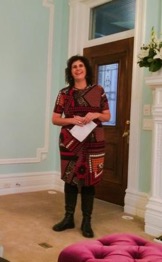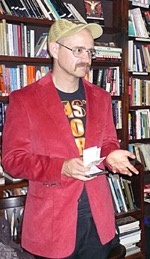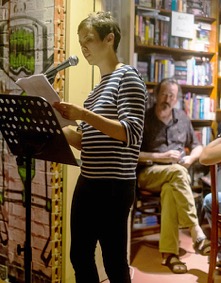Australian Experimental Poetry: Critical and Historical Perspectives
by A.J. Carruthers
These blog posts will contain some critical explorations, reflections and polemics concerning my second book project titled The Languages of Invention: Australian Experimental Poetry and Literary History, 1973-2014. This project comes after Stave Sightings: Notational Experiments in North American Long Poems, 1961-2011,[i] a book I have called a “critical experiment” which examines the use of notational methods and actual musical scores in expansive works by Langston Hughes, Armand Schwerner, BpNichol, Joan Retallack and Anne Waldman. These are disruptive and radical case studies, poetries that test our reading practices, oftentimes engaging in trenchant cultural critique through the registers of what I deemed “scorelike” writing. Now my attention turns―in equally socio-political, equally testing ways―to the field of Australian poetry and poetics.
The argument for my new project is this. There is another history, a history not yet accounted for in the critical study of Australian poetics: the history of its neo-avant-garde and contemporary experimental poetries. Revisionist and countercanonical, this project will explore the audacious strides of a neglected tradition through the lens of what Michael Farrell has called “Australia’s heritage of poetics.”[ii] In the research collected and the structures drawn out for the book a recurrent theme is an emergent character of Australian experimentation after 1970. Australian experimental poetry since 1970 has not just been “derivative,” Euro- or American-centric. It has been driven in significant ways by postwar migration―and so is often staunchly resistant to nationalist frameworks―but derivation just doesn’t capture the global breadth of Australian experimental poetics and really get to the heart of what it is. It cannot be reduced to any single line of influence, and nor is it purely a local construction. What it is, in fact, is yet to be fully understood both on the level of casual public discourse[iii] or critical poetics; hence this research.
In these musings I want to explore some historical problems that occur between neo-avant-garde experiments around an explosion of small press publishing in the 1970s, and the continuation of such work through the 1980s and 1990s toward a unique sensibility and character of Australian experimentation in the present day. I want to also examine specific poems that illuminate such concepts. There’s a pressing need now, I claim, to transform dismissals of “derivation” and “receivedness”[iv] into more entrenched analyses of the transnational and international contexts of the (postwar, then post-1968) neo-avant-gardes, a nexus around which a complex series of negotiations, influences and even outright resistance fueled strenuous and lively responses to the historical avant-gardes both in Australia and around the globe.[v] Though they have been influenced―as all traditions, conventional or not, are―by an originary impetus in the classical avant-garde, what occurred in these transformations and transpositions was a set of unique practices that are not reducible to these forebears.



Two books have opened new possibilities for the study of inventive poetics in Australia. Several key passages in Philip Mead’s 2008 book Networked Language: Culture and History in Australian Poetry outline some crucial challenges for the critical study of experimental poetics. Mead calls for a shift in our critical vocabulary such that it can keep up with the more difficult and inventive poetries produced in Australia:
The consensus about how poetic meanings are generated…hasn’t been able to produce any simple equation that can adduce the meanings of even fairly straightforward instances of poetic language. It doesn’t dispel the unease about the difficult limit cases that some poetic expression presents [ . . . ] What does lyric poetry have to do with ‘society’? More worrying still, it seems, are the instances of poetic language that appear schizophrenically disordered. What’s the point of the textual embodiment of a (deliberate) deficit of ‘meaning’? [ . . . ] Thus, in the Australian context the critical discourse on poetry lags seriously behind, or is out of sync with, the formal innovativeness and linguistic range of historical and contemporary poetic production. It’s as if literary theory and criticism can’t envisage ways forward. (Networked Language 2-3)
The implications of this are vast, and my wager is that a close study of experimental poetry in itself, precisely those limit-cases, studied on their own terms and with attention to both “linguistic range” and material contexts, can reveal the “ways forward” that Mead seeks.[vi] Only the study of experimental poetry, that is, can get us to “catch up” and cancel out this critical lag. Michael Farrell’s recent book Writing Australian Unsettlement: Modes of Poetic Invention 1796-1945 (2015) also has broad significance for the critical study of experimental poetics in that it proposes a long(er) “poetics history” of modes of “poetic invention,” both in well-known texts like Ned Kelly’s Jeriderie Letter and in unlikely/unknown ones, like Ah Sing’s The Case. As instances of inventive writing, Farrell reads themes of coloniality and “unsettlement” (via Mead) down to those very smallest linguistic and lettristic units (punctuation, mark, trace). Both Mead and Farrell, in different ways, provide critical foundations for an examination of experimental poetry, giving us a sense of its history and how to begin with a poetics. They set the stage for readings which don’t separate an attention to aesthetics and linguistic invention from the socio-historical, but rather read the social as embedded in those tiniest facets and sonic traces that constitute the material text.

It doesn’t get any easier than this, of course; or off-course, implying a certain conceptual drift any good idea has to undergo. Complications fly up or jam down at the feet of the neo-avant-garde poem, textual fabrication or betrayal might greet the critic at this juncture (can we be sure these poems are real? aren’t hoaxes?). And what is, or what was, the avant-garde? How do we read its radical oppositionality, from politics to aesthetics and back? Not all avant-garde poems are oppositional, and not all avant-garde poets, surely, write poetry to “communicate” a politics. As the USAmerican scholar Brian Reed puts it in Nobody’s Business: Twenty-First Century Avant-Garde Poetics:
Since the 1960s, avant-gardism has a mixed, complex history as a critical concept. Can an authentic avant-garde still exist? Or can there only be shallow effete echoes of past movements and achievements? Can an avant-garde ever actually succeed in bringing about revolutionary social transformation? Does an espousal of vanguardist aims amount to enslaving art to the logic of the marketplace, especially the constant demand for new products and new fashions? Is avant-gardism inherently masculinist? Is it solely a Western phenomenon? (Reed 2013, xiii)
None of these questions can be fully accounted for in any project, but a degree of boldness does us some good: experimental poetry in Australia has often been revolutionary, suspicious of power and institutions, wildly oppositional―sometimes to the detriment of careers―and resolutely against the logic of the marketplace. Yet politics is also about reading. We can and must reveal gender contradictions and assumptions around avant-gardism, and in as many ways as possible, get critical on “Western Civ” and its Imperial Englishes; Australian experimental poetry does this well. I remain gnostic about the fate of the term avant-garde, and equally critical of those aspects of it that cannot put on notice social contradictions around class, culture, gender, race/ethnicity, and thus choose the word “experimental” once those historical markers of “neo” become less relevant in the present day. A further distinction, between neo-avant-garde and contemporary experimental, will become necessary. But that for later.
Still more foundationally: What is an experimental poem? Though an experimental poem is never one thing only, I have found that it is not impossible to define. Its main facets are at least somewhat amenable to description. To start with: an experimental poem impacts the concepts, materials and theories of the poem in ways that lead us to question what a poem is. Two: an experimental poem also has a history of necessitating what I call the emancipation of disjunction, that is to say, it asks us to reconfigure some aspects of our reading practice and to be open to dissonance (to borrow the musical term), or disjunction (on the page), all that static between the communicative aspects of language and the messy patterns and erratic swerves of language itself. Three: from this, it draws us close to those smallest units of poetic activity: line, trace, segment, lettristic drift, things that can are not neutral; they enrich socio-cultural readings of experimental poetry.



While my definition is based on the work itself, I want to again emphasise the sociality of experiment as a form of social identification or negotiation that informs practice, and vice versa. A poet may publicly claim to be experimental, and enjoy the moniker, but not write very experimental work. Or, they might write fairly experimental work, and not identify as experimental. Other poets might privately write experimental poetry but in their public persona write more traditional verse (for major magazines, in published books, etc.). Other still might support experimental work publicly, but privately favour conventional poetry. For the most part, the type of poetry most relevant to this project is written by poets who both profess experimentality and enact experimentality (or, to add one more, those who have been accused of bring experimental).
With regard to historical and social locales, and to synthesize the above point, let me put it this way: “being experimental” is a set of socially mandated and/or culturally oppositional stances, practices and performances encompassing historical reference, interventions into or rehearsing of formal avant-garde traditions (international and local), culturally-specific styles and acts of writing, socio-historical association, tendency or grouping, claiming marginality (often for good reason), and even individualist “maverick” proclamation or provocation (rejecting grouping, and as a result claiming inimitability). Being experimental can be a self-nomination but it can also come about through social circumstance, being amongst likeminded experimenters. Defined this way, we can begin to think of experimentality not as a clearly demarcated anti-canon, but as a set of practices that are fully adopted by some, partially taken by others, and for others still, unambiguously rejected.


My hope is that this project can assist readers in their own thinking, and that this might generate future dialogues around histories of invention in Australia. Through this history I hope to show another side to Australian poetry, a side that, once the critical lens is adjusted, can become a focal,-or hinge-point around which a vast bulk of Australian poetry can be reconsidered. Let me say this as a poet and as a critic: the best poetry in Australia has been and continues to be experimental, it continues to be “at its core.” In the next post, titled “The Australian Neo-Avant-Garde: Beginnings, 1973-1992,” I will explore some key figures of this period and their poetic practices that will serve as the opening instances of this study. Following this I will examine some recent trends in contemporary Australian experimental poetry, from the 1990s to the present day. In the final post I will offer some suggestions for future directions in experimental poetics.
[i] For a description of this book and its aims see:
https://www.palgrave.com/de/book/9783319462417.
[ii] See Farrell’s Writing Australian Unsettlement: Modes of Poetic Invention 1796-1945 (2). Discussion further below.
[iii] Given how much of the key figures and their works I will need to cover to get to an elementary historical picture of the neo-avant-garde, these blog posts will not be able to include opinion and commentary about the “worth” of experiment in Australia, questions of plagiarism/citation, casual, non-critical commentary about the obscurity of experimental poetry, the relation to Language Writing (there is much experimental poetry in Australia which has little to no relation to Language Writing [and there is much experimental writing in North America which is not directly related to Language Writing]) or the experimental-lyrical relation/divide. Readers might find ramifications for these commentaries in the critical arguments presented here, but given the sheer scale of the works by these specific experimental poets, time hasn’t allowed those more opinion-based commentaries to be factored in to this discussion.
[iv] Or complex appraisals of vanguardist “invasion” versus/or alongside regionalism. See John Kinsella’s “Spatial Relations” in Spatial Relations Volume Two, or here online: http://www.johnkinsella.org/essays/spatial.html
[v] Several excellent studies exist of transnational neo-avant-gardes, belated avant-gardes and post-avant-garde experimental practices. A particularly relevant one for this study is Dubravka Djurić and Miško Šuvaković, Eds. Impossible Histories: Historical Avant-gardes, Neo-avant-gardes, and Post-avant-gardes in Yugoslavia, 1918-1991. Cambridge: MIT Press, 2003. The use of three categories, the historical or “classical” avant-garde, the neo-avant-garde, and the post-avant-garde has been useful in making sense of that complex transfer between modern/neo and contemporary experimental that occurs in Australian poetics history.
[vi] As I read it, Mead’s strongest follow-up on these critical leads occurs in his readings of Lionel Fogarty and Π.O. See pp. 399-454.